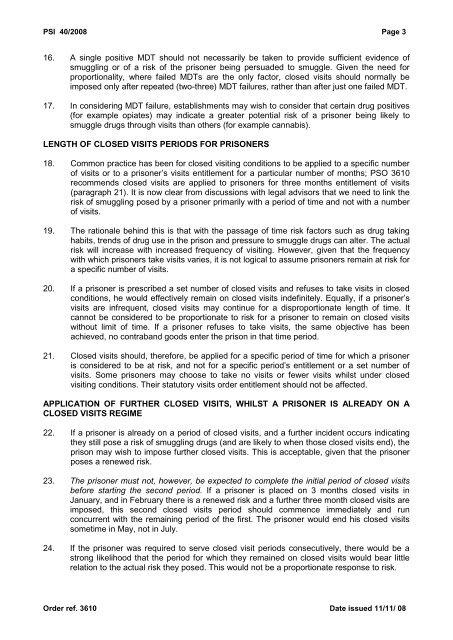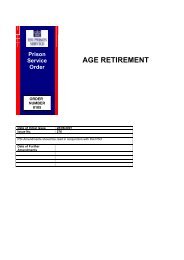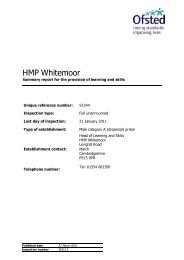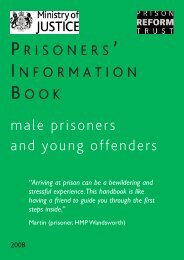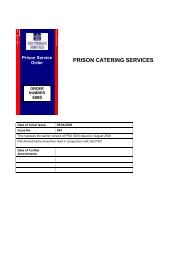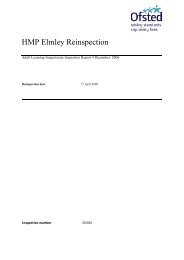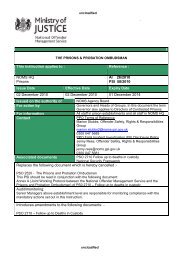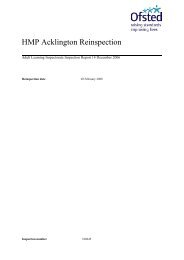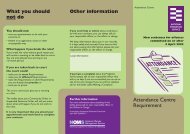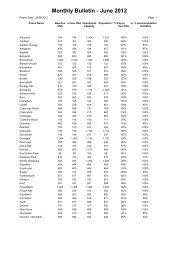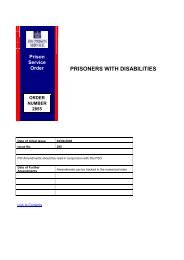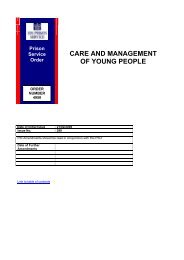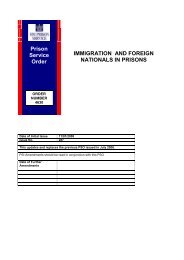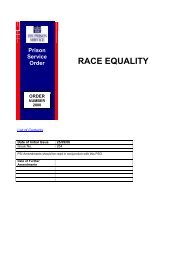Prison Service Instruction Number - Inside Time
Prison Service Instruction Number - Inside Time
Prison Service Instruction Number - Inside Time
You also want an ePaper? Increase the reach of your titles
YUMPU automatically turns print PDFs into web optimized ePapers that Google loves.
PSI 40/2008 Page 316. A single positive MDT should not necessarily be taken to provide sufficient evidence ofsmuggling or of a risk of the prisoner being persuaded to smuggle. Given the need forproportionality, where failed MDTs are the only factor, closed visits should normally beimposed only after repeated (two-three) MDT failures, rather than after just one failed MDT.17. In considering MDT failure, establishments may wish to consider that certain drug positives(for example opiates) may indicate a greater potential risk of a prisoner being likely tosmuggle drugs through visits than others (for example cannabis).LENGTH OF CLOSED VISITS PERIODS FOR PRISONERS18. Common practice has been for closed visiting conditions to be applied to a specific numberof visits or to a prisoner’s visits entitlement for a particular number of months; PSO 3610recommends closed visits are applied to prisoners for three months entitlement of visits(paragraph 21). It is now clear from discussions with legal advisors that we need to link therisk of smuggling posed by a prisoner primarily with a period of time and not with a numberof visits.19. The rationale behind this is that with the passage of time risk factors such as drug takinghabits, trends of drug use in the prison and pressure to smuggle drugs can alter. The actualrisk will increase with increased frequency of visiting. However, given that the frequencywith which prisoners take visits varies, it is not logical to assume prisoners remain at risk fora specific number of visits.20. If a prisoner is prescribed a set number of closed visits and refuses to take visits in closedconditions, he would effectively remain on closed visits indefinitely. Equally, if a prisoner’svisits are infrequent, closed visits may continue for a disproportionate length of time. Itcannot be considered to be proportionate to risk for a prisoner to remain on closed visitswithout limit of time. If a prisoner refuses to take visits, the same objective has beenachieved, no contraband goods enter the prison in that time period.21. Closed visits should, therefore, be applied for a specific period of time for which a prisoneris considered to be at risk, and not for a specific period’s entitlement or a set number ofvisits. Some prisoners may choose to take no visits or fewer visits whilst under closedvisiting conditions. Their statutory visits order entitlement should not be affected.APPLICATION OF FURTHER CLOSED VISITS, WHILST A PRISONER IS ALREADY ON ACLOSED VISITS REGIME22. If a prisoner is already on a period of closed visits, and a further incident occurs indicatingthey still pose a risk of smuggling drugs (and are likely to when those closed visits end), theprison may wish to impose further closed visits. This is acceptable, given that the prisonerposes a renewed risk.23. The prisoner must not, however, be expected to complete the initial period of closed visitsbefore starting the second period. If a prisoner is placed on 3 months closed visits inJanuary, and in February there is a renewed risk and a further three month closed visits areimposed, this second closed visits period should commence immediately and runconcurrent with the remaining period of the first. The prisoner would end his closed visitssometime in May, not in July.24. If the prisoner was required to serve closed visit periods consecutively, there would be astrong likelihood that the period for which they remained on closed visits would bear littlerelation to the actual risk they posed. This would not be a proportionate response to risk.Order ref. 3610 Date issued 11/11/ 08


